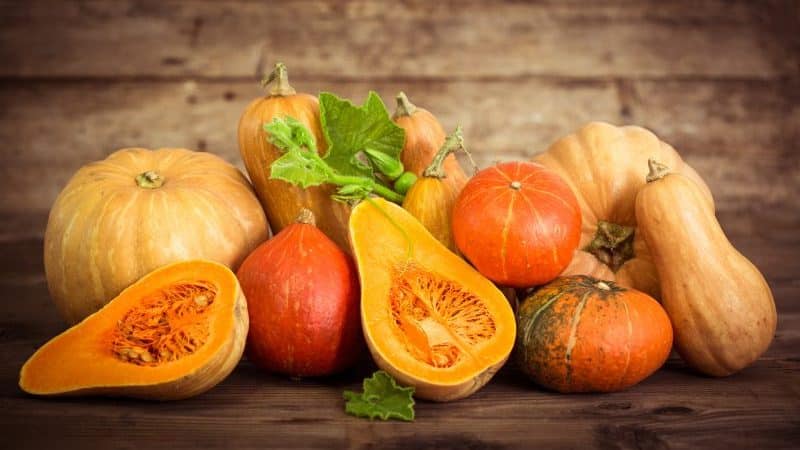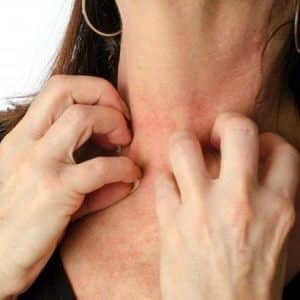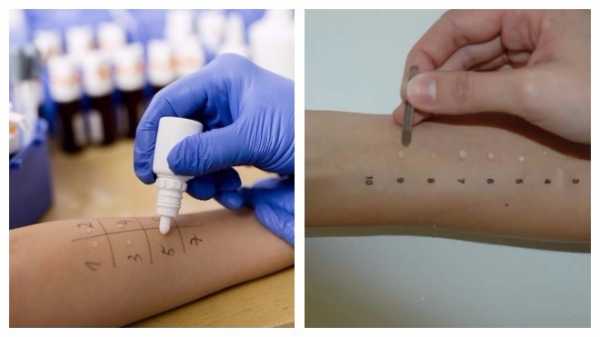What to do if you are allergic to pumpkin: treat effectively and prevent in advance
Pumpkin has a rich vitamin and mineral composition, tender flesh and a pleasant taste. Thanks to these qualities, it is widely used in children's and diet menus. However, in rare cases, the vegetable can cause food allergies. An atypical reaction of the body is individual, most often manifested in the form of swelling, skin rashes and disruption of the digestive system.
If you suspect a food allergy, it is important to accurately determine the cause. The most important diagnostic methods are allergy tests and keeping a food diary.
Why is there an allergy to such a healthy vegetable as pumpkin?
Pumpkin contains dozens of different vitamins and microelements. Of particular value are fatty acids, vitamin K, T, PP. A large amount of fiber helps normalize the functioning of the digestive system.
B vitamins have a beneficial effect on the nervous system. However, specific proteins and carotene can cause an atypical reaction in the body.
What is the likelihood of allergies
Can pumpkin cause allergies? There is definitely such a possibility. Bright varieties with an orange peel and pulp are considered dangerous, which is due to the content of beta-carotene - for allergy sufferers They are best avoided. Green, yellow and white vegetables are less dangerous.
The photo shows a variety of pumpkin varieties.

Causes of an allergic reaction to eating pumpkin
Pumpkin can cause true and false allergies.In the first case, carotene causes the reaction. In this case, other red and orange vegetables are contraindicated for a person. Food intolerance can be caused by special proteins that are found only in pumpkin.
A false allergy is a one-time phenomenon; it can be triggered by the following reasons:
- eating a large amount of vegetables at one time;
- content of harmful substances in the product: toxins, nitrates, pesticides;
- a reaction to other substances in the finished dish, for example, preservatives, spices, dyes.
Allergies when eating pumpkin
An allergic reaction to pumpkin can occur both when first consumed in infancy and suddenly in adulthood.
Reasons that provoke an atypical reaction of the immune system:
- hereditary factors;
- immaturity of the digestive system in infants;
- existing allergic diseases;
- diseases of the digestive system.
Allergy to pumpkin in an infant
Pumpkin is often used as complementary food. However, pediatricians do not recommend using the vegetable for the first feedings. Pumpkin puree is administered after hypoallergenic vegetables: zucchini, broccoli, cauliflower.
Due to the immaturity of the food system, allergic reactions to carotene are possible after eating the vegetable. Common symptoms of an immune response in infants are dermatitis, seborrhea, and colic.
Important! The allergen can enter the baby's body through mother's milk. A nursing woman should monitor her diet and her newborn's reaction to pumpkin while breastfeeding. Recording observations will identify allergies when symptoms first appear.
What are the symptoms?
With a true pumpkin allergy, symptoms appear within a few hours after eating the vegetable.
Digestive system disorders
An allergic reaction of the digestive system occurs more often in children. The irritant acts on certain areas of the intestine where clusters of immune cells are located.
Manifestations of gastrointestinal dysfunction are different:
- colic in babies;
- pain in different locations in children over three years of age;
- stool disorders;
- vomit.
Be sure to keep an eye on your baby's bowel movements. The appearance of mucus and undigested food in the stool indicates a disruption in the functioning of the digestive system, which may be caused by an allergy.
Attention! Symptoms of gastrointestinal irritation due to allergies in a small child are close to the manifestations of other diseases, including intestinal infections and viruses. The doctor will make the correct diagnosis after laboratory tests, including culture for pathogenic bacteria.
Oral allergy syndrome
Oral allergy syndrome (OSA) occurs in patients suffering from two or more allergens. The main irritant is plant pollen, under its influence a person has a reaction to fresh fruits and vegetables.
Symptoms of OSA include:
- itching, redness, numbness, tingling in the mouth and gums;
- swelling of the oral area;
- runny nose, sneezing;
- conjunctivitis.
Important! Often, a person suffering from a pollen allergy does not associate the symptoms with the consumption of foods. This leads to an incorrect diagnosis and accumulation of the allergen in the body.
OSA appears immediately after eating the vegetable. In rare cases, a reaction occurs within 1-2 hours. Symptoms usually disappear on their own.However, the immune response can sharply intensify and lead to serious consequences, including asphyxia.
Attention! The baby cannot correctly describe the symptoms of OSA and adequately express his feelings. The baby begins to be capricious and refuse the pumpkin. It is important for parents to establish the reason for not accepting the product.
Damage to the skin and mucous membranes
When an allergen accumulates in the body, delayed reactions may occur: various lesions of the skin and mucous membranes. In a broad sense, all immune changes in the epidermis are called dermatitis.
Common symptoms include:
- redness;
- swelling;
- getting wet;
- ulcers, blisters, pustules;
- seborrhea;
- strengthening of the skin pattern.
Treatment involves eliminating the allergen from the diet and using various ointments and folk remedies. Allergies can manifest as damage to the mucous membranes of the mouth, nose, and eyes.
Allergic swelling of the eyelids
After eating pumpkin, swelling of the eyelids and other organs may develop. Associated symptoms include headache and general ill health before more noticeable symptoms appear. The eyelids greatly increase in volume, and it becomes difficult to open the eyes. The patient complains of discomfort and pain.
Sometimes the reaction spreads to other tissues of the eye, leading to increased intracranial pressure.
Quincke's edema is close to the named phenomenon. This allergic reaction manifests itself in sudden swelling and an increase in the volume of the face, larynx, and internal organs.
Important! If there is swelling of the eyelids or other parts of the face, it is important to immediately call an ambulance. Asphyxia due to swelling of the larynx can become a serious complication.
Diagnostics
To make an accurate diagnosis, a set of diagnostic methods is used:
- allergy test;
- food diary;
- elimination tests or exclusion of a product from the diet.

The body's immune response to pumpkin is associated with an increase in the blood protein IgE - immunoglobulin E. Symptoms can appear immediately after consuming the product or within two hours after that.
Laboratory testing can detect elevated IgE levels. Venous blood is used for analysis. A special pumpkin protein is introduced into the biological material. An increase in IgE levels is considered a positive result and almost certainly indicates intolerance to the product.
Testing is used in allergy treatment. Research results show the effectiveness of the therapeutic diet and the severity of the disease.
Mild to moderate symptoms
The degree of manifestation of symptoms depends on the individual characteristics of the organism, the amount of allergen and the time of its exposure. Mild symptoms do not threaten human life and go away on their own after eliminating the irritant.
These include:
- redness and slight swelling of the skin and mucous membranes without compromising the integrity of the epidermis;
- lacrimation, sneezing, runny nose;
- itching, redness in the mouth.
Symptoms of moderate severity worsen the patient’s quality of life and lead to complications.
The most dangerous signs are:
- Quincke's edema, in which swelling covers large areas - the face, throat, internal organs;
- bronchial asthma;
- extensive dermatitis;
- swelling of the eyelids with subsequent damage to other eye tissues.
Attention! If the symptoms of Quincke's edema are pronounced, call an ambulance immediately. If anyone in the family has allergies, it is important to have an anti-allergy remedy in your home medicine cabinet.
How to deal with allergies
The main method of dealing with food allergies is to eliminate the food that causes it from the diet. Next, symptomatic treatment is carried out.
The most common ointments against allergies
To eliminate skin manifestations of allergies, ointments, creams and gels are used. Each remedy has a different degree of effectiveness. Hormonal drugs have the most pronounced effect, but they have a large list of contraindications and side effects.
Common ointments for treating allergies:
- "Fenistil" – relieves itching and redness, contains antihistamines, is indicated for use in childhood from the second month of life.
- Zinc ointment has a drying effect, disinfects and promotes healing of affected areas, does not contain hormones, and is safe for children.
- "Bepanten" – promotes healing, eliminates excessive dryness in allergic dermatitis, has no contraindications, and in rare cases can cause allergies.
- "Advantan" – a hormonal drug of the latest generation, suitable for use in children from four months of age, requires compliance with the dosage and period of use, effectively suppresses allergic reactions on the skin.
- "Gistan" - hormonal agent. Not recommended for long-term use and requires gradual withdrawal. It has a number of contraindications; in children it is used from two years of age under the supervision of a doctor.
Traditional recipes against allergies
To treat skin manifestations of allergies, lotions, compresses, ointments with medicinal herbs and other natural ingredients are used.
The following plants have an antihistamine effect:
- pharmaceutical chamomile - in addition to the antiallergic effect, its decoction has anti-inflammatory and antiseptic effects;
- the pharmaceutical series relieves allergies, suppresses the inflammatory process, and disinfects;
- yarrow accelerates tissue regeneration processes and reduces allergies.
For increased dryness and flaking of the skin, use vegetable oils: olive, sunflower. To achieve a pronounced effect, lotions and compresses are used. It is not recommended to lubricate damaged areas of skin with oil.
Attention! Before using medicinal herbs, consult your doctor and use the product on a small area of skin. Plants can also cause allergies.

Hypoallergenic diet
Avoiding pumpkin is the main way to treat food allergies. Not only the main product is excluded, but also related vegetables.
The pumpkin family includes:
If you have a strong reaction to pumpkin, it is important to avoid processed foods that contain pumpkin. This could be baby cereals, purees, cereal bars. Such information is indicated on the packaging when describing the composition.
If the reaction is caused by the bright skin of the pumpkin, you should be wary of other red and orange vegetables: apples, tomatoes, peppers, carrots and others.
The most effective sorbents
To more quickly cleanse the body of the allergen, the doctor may prescribe sorbents. The most popular include:
- Activated carbon;
- "Enterosgel";
- "Polysorb";
- "Atoxil".
Sorbents are taken as soon as possible after consuming the allergen, while it is in the digestive system. The medicine binds fatty acids and reduces their absorption in the intestine.
Attention! Long-term use of sorbents will lead to depletion of the body, the removal of not only toxins and allergens, but also useful substances.
Antihistamines
Antiallergic medications lower histamine levels and stop the attack. The most effective antihistamines include:
| Name | Active substance |
| Xizal | Levocetirizine |
| Suprastin | Chloropyramine hydrochloride |
| Allegra | Fexofenadine |
| Zyrtec | Cetirizine dihydrochloride |
| Loratadine | Loratadine |
Prevention of allergies in adults
An allergy to pumpkin may first appear in adulthood. Failures in the functioning of the immune system are provoked by chronic gastrointestinal diseases, smoking, drinking alcohol and foods with a high content of artificial additives.
There are ways to reduce the number of allergens in pumpkin:
- choose green varieties, avoid bright orange vegetables;
- cut off the peel and select the seeds;
- give preference to thermally processed vegetables.
Recommendations for parents
Pumpkin is not considered a highly allergenic product and is used as complementary food for children after six months. However, pediatricians advise introducing the vegetable after zucchini, broccoli, and cauliflower.
Start feeding pumpkin puree with half a teaspoon. If there is no reaction, gradually increase the amount. To identify allergies and detect dangerous foods, keep a food diary.
Important! Give preference to local seasonal vegetables, avoid imported products.
Reviews
Although an allergy to pumpkin is a rare occurrence, there are reviews about it.
Olga, 29 years old: “I started introducing pumpkin puree into complementary foods. The child has already tried zucchini and cauliflower.The day after the first feeding, I noticed spots on the thigh and elbows. I got scared and refused the pumpkin. The pediatrician prescribed us Suprastin drops. The redness was smeared with Bepanten.
Valentina, 41 years old: “Since childhood I have not been able to eat red and orange vegetables. As soon as it happens, hives appear. Fenistil helps relieve itching. The reaction does not appear to green pumpkin, but just in case, I cut off the peel from it and do not eat the seeds.”
Conclusion
In rare cases, pumpkin can cause true food allergies. The reason is the large amount of keratin in orange varieties and immunoglobulin E. The most dangerous are bright varieties and eating the vegetable raw.
The main treatment is a diet without pumpkin vegetables. To relieve an attack and treat symptoms, antihistamines, sorbents, and medicinal ointments are used.